REBECCA RENNIE BIG BOARD: SMALL SCHOOL TOP 50 (Page 4)
By Rebecca Rennie
As with every draft class, there is exceptional talent to be found outside the FBS. This presents my Top 50 of those small school prospects. This is year two of producing this form of content. Though less extensive than the Top 150 presented last year, I believe the process and resulting content is much better this time around. Surprisingly, the near 22,000 word count actually exceeds that of last year’s big board write up.
The first four pages provide profiles on the Top 40 small school prospects. Page 5 contains the full Top 50 Big Board as a list. There is a lot of high quality prospects in the 2021 class from the FCS and beyond. Those appearing near the bottom on the list are fully capable of enjoying a pro career with the right opportunity. There are a number of players also absent from this list. I’ve attempted to watch as many as possible but know that a few will have been missed.
There is a lot of content within this project, and would be surprised if many intend to read this start to finish. However, whether used pre-draft or after your team has picked up one or more of these players during or after the draft, I hope this provides some useful information or reference.
31. Sam Kamara, DL, Stony Brook. Grade: HPFA
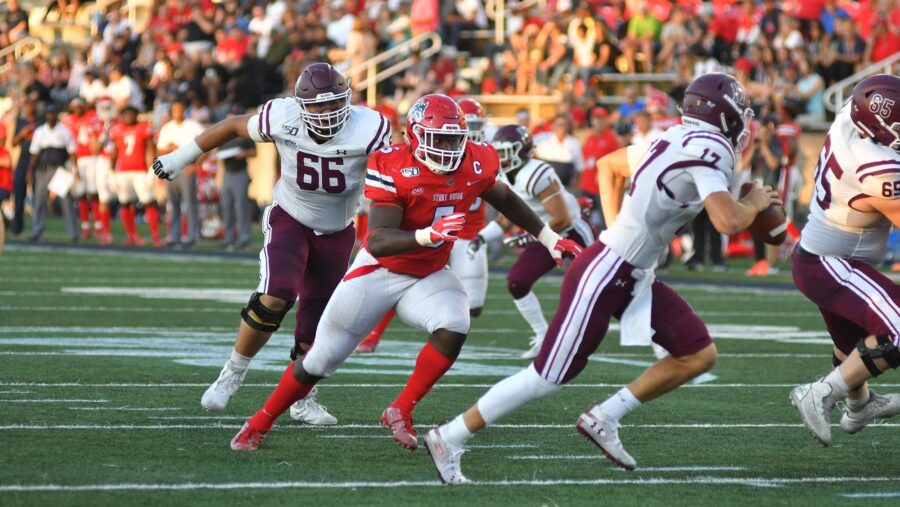
Height: 6’1”. Weight: 275 lbs.
Pros: Kamara was set to be a quality small school prospect for the 2020 NFL draft class last year. Performing well in an early season matchup with Utah State in 2019, his senior year was ended after only three games. Returning from that torn pectoral, he has played in the 2021 spring season for the Seawolves. Earlier this month, he announced his intentions to conclude his college career as a late addition to the 2021 class.
The short but stout defensive lineman is well built and sturdy with good balance and strength. He may lack ideal length but makes use of his low center of gravity and natural pad level to create leverage and maximize his power. He plays with excellent balance and form to hold up well at the point of attack, proving tough to work backward. He has some inside-outside versatility but may project best as a 3-4 defensive end.
The aggression and motor are trademarks of Kamara’s play style. Quickly firing from his stance, he brings active violent hands but with a varied arsenal of rush moves. He rips through block attempts well, offers a rapid swim move and shows a good speed-to-power switch-up. His most productive season came in 2018. Kamara totalled 42 tackles, 11.5 TFLs and 9 sacks that year. In the 8 games combined over 2019 and 2021, he put up 7.5 TFLs, 5 sacks and 3 forced fumbles.
Cons: Returning to the field in 2021 as productive as previously was great to see after the torn pectoral. Hopefully there are no long-term medical concerns following that injury. Kamara maximizes what he has available and compensates with good power, but his length at 6’1 flat may not meet thresholds for some teams at the position.
Wrapping Up: Kamara may not have the highest of ceilings as a pro. However, he has NFL-caliber strength and toughness to hold up at the next level. Able to contribute across the defensive line he can offer a versatile depth role to the roster. He has one of the angriest play styles to be found in the trenches in this draft class. Kamara will not give any opponent a quiet rep from start to finish.
32. Brady Davis, QB, Illinois State. Grade: HPFA
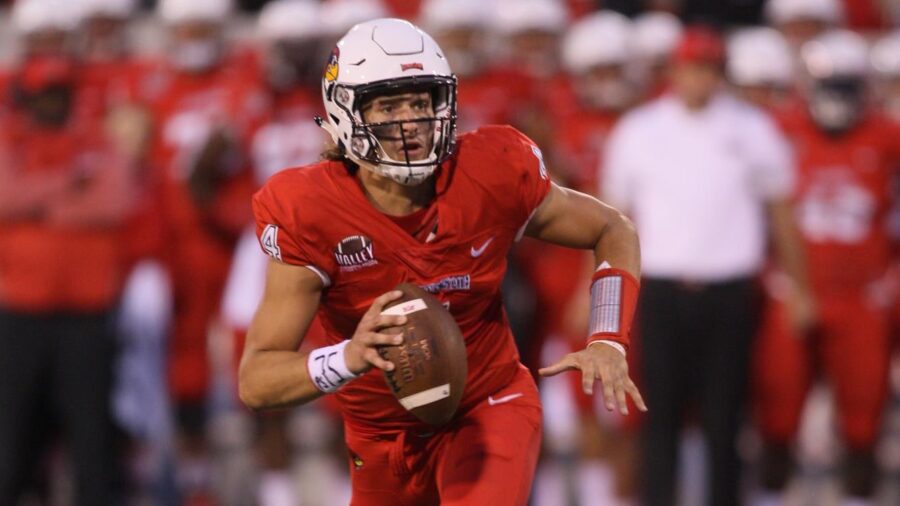
Height: 6’2”. Weight: 206 lbs.
Pros: A transfer from Memphis, Davis found the playing time he was seeking with Illinois State. He made an immediate impact with the Redbirds, making the Missouri Valley Conference All-Newcomer team in 2018. His two seasons starting at the FCS level included some fantastic highlights and playmaking. He has received his share of attention as a sleeper prospect among draft fans and media as a result.
Davis has a decent sized frame and good mobility. His film frequently features Davis running bootlegs, extending plays, escaping the pocket. He can scramble as plays break down and offers enough mobility to take off as a runner if required. Able to get ideal zip on his throws from a quick release, he is capable of an aesthetically satisfying spiral to make NFL-caliber throws to multiple levels of the field.
Against better opposition to open the 2019 season, Davis made some outstanding fourth quarter throws against Northern Illinois that demonstrated what he is capable of when his game is on. An on-point 3rd-and-long conversion was followed by a deep-ball touchdown that showcased Davis at his best. Statistically, Davis’ best season came in 2018, including a 19:5 touchdown to interception ratio. Though unable to take part in the post-season, Davis helped lead Illinois State to a playoff appearance in 2019.
Cons: The flashes and highlights are impressive but snap-to-snap, Davis is wildly inconsistent both technically and mentally. While he has the movement to escape the pocket, Davis doesn’t appear to scramble with confidence and hesitates a bit as a runner. Accuracy and decision making can go out the window under pressure. Too often he makes very poor choices attempting to throw his way out of trouble. When trying to make off-balance and off-platform throws, it rarely goes well.
The upper/lower body coordination and overall footwork is disappointing and contributes to much of the erratic throws and inaccurate ball placement. Too often the ball hits the turf short of intended receivers when not stepping into his throws correctly, which is frequent. Currently, each throw appears to be made with differing form and footwork from the last, rather than well-drilled, repeatable mechanics. There is certainly potential but that could take time to develop.
The medical history also hurts his draft stock. Over three seasons with Memphis, Davis only appeared in one game in 2017. That included missing the 2016 season due to a torn ACL suffered in the preseason. At Illinois State in 2019, he again injured his knee, costing him to miss the Redbirds’ playoff run. Prior to that, he had thrown 9 interceptions to go with 9 TDs on the year. In addition to the durability concerns, he’s also a slightly older prospect. The 2020 season was set to be his sixth in college.
Wrapping Up: Davis has some developmental tools, centering around a live arm with zip on his throws. While past knee injuries are a concern, he has shown mobility when on the field. The highlights are great, but the consistency is not there currently. He may be worth an invite into camp, but a draft selection feels optimistic. There are questions over Davis’ anticipation and decision making, alongside volatile footwork, coordination and release mechanics.
33. Calvin Ashley, OT/IOL, Florida A&M. Grade: HPFA
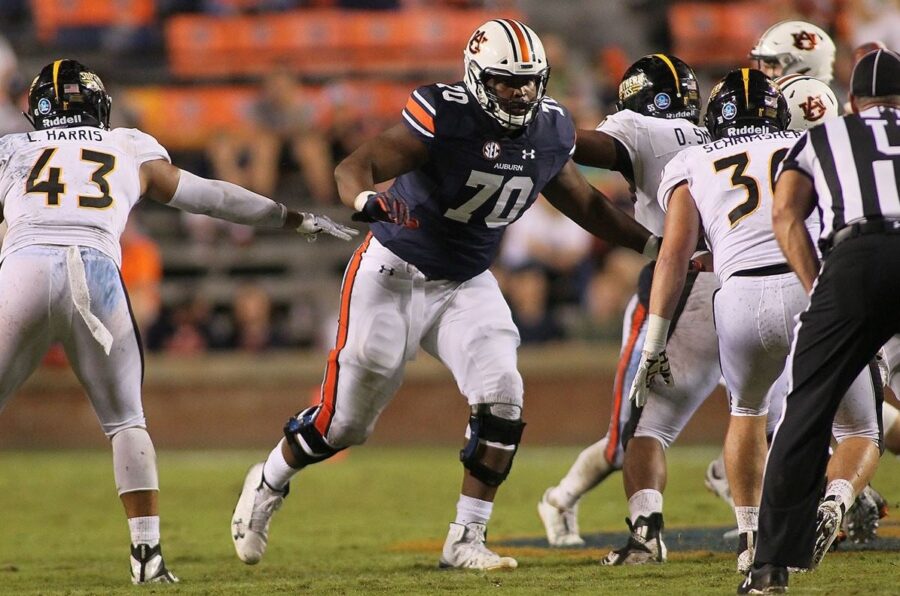
Height: 6’6”. Weight: 315 lbs.
Pros: Of the fringe-draftable small school prospects in this class, Ashley entered college as one of the more high profile. Starting out as a 5-star commit at Auburn, he has some impressive physical tools that led to earning that early hype. The double-transfer to Florida Atlantic initially, then to Florida A&M will certainly raise eyebrows. However, the second move was explained as being for family reasons, to be closer to his wife and new son.
Ashley stands out for his imposing prototype frame. He flashes examples of having the expected power to match the stature. The size and strength allow him to absorb bull rushes when his footwork and hands are solid.
While not explosive, his lateral movement is fairly smooth. There’s potential to offer depth across various spots on the offensive line. The Rattlers transfer has played primarily at right tackle, with physicality potentially applicable to playing guard also.
Cons: Ashley did not see the field as often as desired in college. He made one start in five appearances over his two seasons with the Tigers. While set to start in 2020 before cancellation, he was not always present in the lineup the previous year. Furthermore, while there are flashes, the film itself is not overly encouraging in truth.
Too often, Ashley resorts to bending at the waist to maintain contact. Already poor coordination and overall form would get more ragged as plays progressed and defenders worked against him. His hands are frequently late, misplaced and not sustaining contact. There are signs of concerns with body control and balance, not helped by often high pad level. At times this negated some strength advantage and led to being on the turf a little too often.
His overall movement, though reasonably smooth, looked a bit slow and lethargic. Late reactions out of his stance and initial movements often leave him a step behind. Despite potentially dropping up to 20 lbs from his listed weight of 335 lbs, he tested disappointingly at his pro day. He ran a 5.55 dash (1.89 split), and an 8.46 3-cone.
For his size and power, Ashley’s motor and aggression seemed too varied. In addition, the mental side of his game raises questions. The awareness and anticipation can let him down too often and he can be exploitable via late pressure. Reactions and adjustments required to counters are not ideal.
Wrapping Up: Ashley’s NFL projection is a balance between some underwhelming film and obviously intriguing physical tools to work with. There could yet be some untapped potential to harness. The path of Ashley’s college career certainly did not go as planned. He also could have shown steps in his technique and execution had his opportunity to play in 2020 not be taken from him. If he goes undrafted, he ought to be a training camp invite afterward.
34. Zech Thomas, IOL, Pittsburg State. Grade: HPFA

Height: 6’2”. Weight: 310 lbs.
Pros: The depth of small school offensive line talent in the 2021 draft class is exceptional. So much so, that several are arguably further under-the-radar than usual. Zech Thomas will be an unknown prospect to many, but several teams have indicated interest in the Pitt State guard. At his pro day, a Kansas City Chiefs scout put him through his workout as one of the teams in attendance. Thomas was also an invite to the under-rated Hula Bowl event during the pre-draft process.
Thomas is relatively short at just under 6’2. He has enough length for the interior O-line though, measuring in just short of 33” arms, in addition to 10 ¼ hands. He is well built with a broad and thick lower half, befitting the “bubble butt” Mayock-ism. The Gorillas lineman plays with naturally good leverage and pad level.
Thomas moves very well for his size. He is notably light on his feet with a spring in his step, quick movements over short areas. The agility on show gives Thomas potential to be effective as a pulling guard. He brings the desired physical mindset as an aggressor at the point of attack.
Cons: As good as the movement traits are, Thomas has some way to go to refine his game. He can be disappointing in his technique and execution. Most notable is poor hand placement, frequently landing outside with his hands on first contact. He can be practically hugging opponents on occasion. He has the potential to deliver an effective punch off the snap, but currently doesn’t do so consistently.
Thomas has the physique and power to create a stout base and anchor, but the footwork and form can negate that. There is a tendency to reach for contact, bending at the waist in search of his landmarks. When faced with late secondary rush attempts or when plays break down, Thomas can look a little hesitant and uncertain as to where to focus his attention and locate blocks.
Wrapping Up: Thomas proved an enjoyable film study, despite the flaws currently present in his execution. The movement traits provide some upside that is worth investigating, perhaps via a period of time on a practice squad.
35. Donnie Corley, WR/DB, Texas Southern. Grade: UDFA
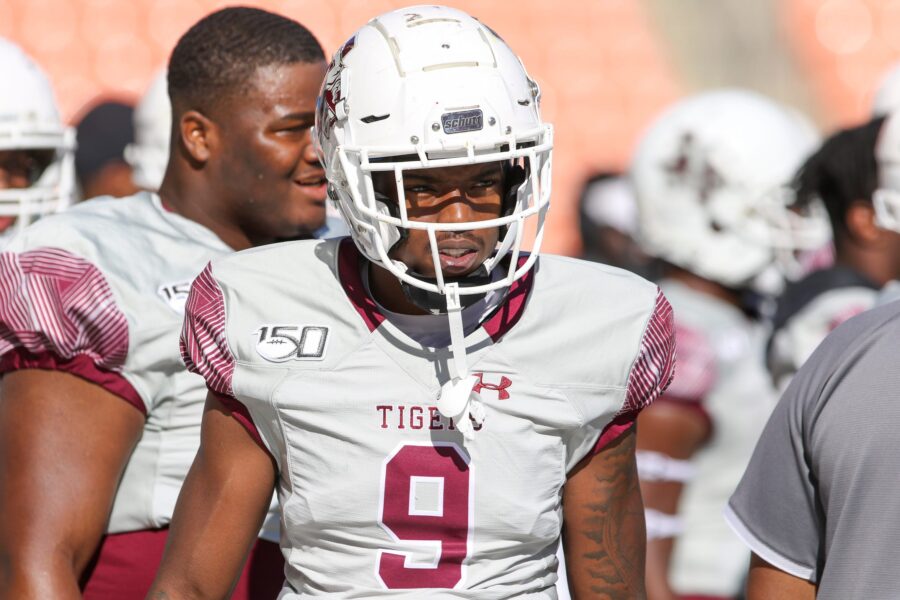
Height: 6’2”. Weight: 195 lbs.
Pros: A former 4-star recruit, Corley was coveted by numerous top programs before settling on Michigan State. He quickly established himself at the college level with an impactful freshman season with the Spartans. Off-field trouble led to his exit and a second chance at Texas Southern, where he produced well. His most recent season in 2019 included 72 receptions for 1,039 yards and 3 touchdowns.
Corley is lean and athletic with quick releases from a standing start. He shows a good combination of footwork and burst over short areas to go with long speed. He proved that with an impressive 6.83 3-cone time at Houston’s pro day. He added a 4.59 dash, 34” vertical and 10-3 broad jump. The Tigers receiver is fluid navigating the field and maintains speed as he makes his breaks. A standout at both the Tropical Bowl and Hula Bowl, he received praise at the latter as the best route runner on his All-Star squad. The abilities are present to separate at the NFL level, making it challenging for defensive backs to keep in phase.
The Spartans transfer has his share of impressive catches on film. Some standout examples include securing the ball in tight windows over the middle. He shows toughness in traffic to complete catches while facing an incoming hit. Good positional awareness sees him adjust well to keep his feet in bounds on sideline targets. His athletic pluses are put to use to pull away from DBs on deep targets and to work after the catch as a runner.
Cons: Character concerns are at the forefront of the questions regarding Corley. He was dismissed from Michigan State following allegations of rape alongside two former teammates. This was denied, while pleading guilty to felony seduction charges. He will inevitably be required to answer questions over the situation. Should he satisfy those queries, he can earn a pro opportunity based on his on-field abilities.
Corley is not without some issues on film also. While he has impressive catches to cite, there are a number of frustrating drops. The variance includes some focus-related drops and examples of looking to turn upfield early prior to securing the ball. His skill set is applicable to a diverse route tree but ran limited routes with the Tigers. His numbers were assisted by a good number of short, friendly targets.
Wrapping Up: It would not be a surprise if Corley is off the board for some teams. Ultimately, he could go undrafted regardless. If that’s the case, he could earn a roster spot or practice squad role as a free agent in training camp. Corley was also listed at the Tropical Bowl as a WR/DB with some experience at the latter position. This would suggest he may also be getting some consideration on the defensive side of the ball.
36. Jack Batho IV, OT/IOL, South Dakota Mines. Grade: UDFA
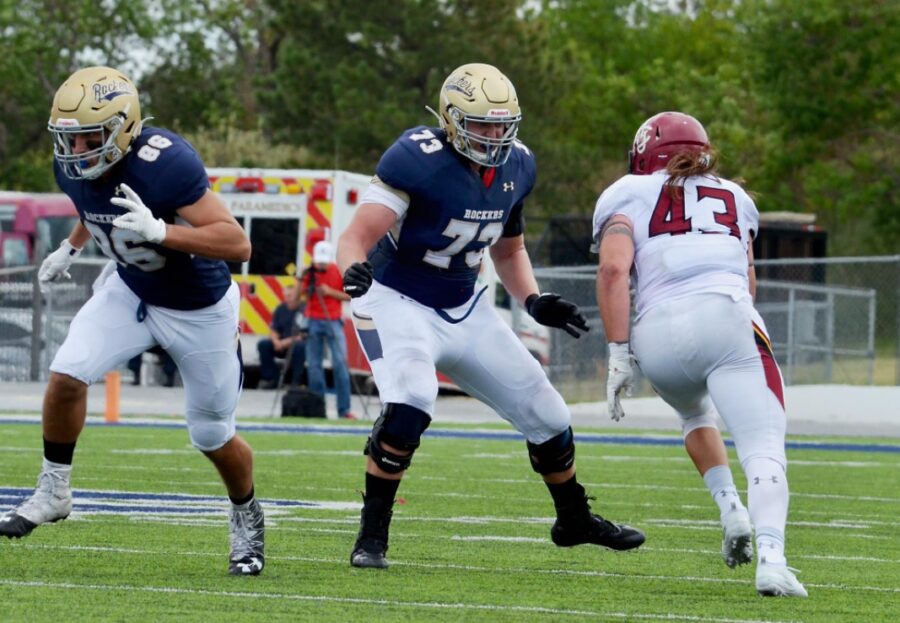
Height: 6’7”. Weight: 315 lbs.
Pros: With a massive frame, Batho not only towers over D2 competition, but also did at the Hula Bowl All-Star event. At college and in Hawaii he lined up at left tackle. His abilities will likely see him either switch to right tackle or inside at guard. Previously listed on his team website at just 285 lbs, he now weighs in at 315 lbs. In addition to the height, he is broadly built with good length in his 35 3/8” arms and 83” wingspan.
Unsurprisingly, Batho frequently dominates on film for the Hardrockers. Heavy hands consistently shut down pass rushers who attempt to directly challenge him at the point of attack. Destructive run blocking saw him regularly flatten overwhelmed defenders at the line and on the second level. His 21 bench reps was a solid number given his arm length.
As a pass protector, Batho is quite impressive technically. His upper and lower body are well coordinated, gets good extension and plays with balance. Mentally tough, he was not deterred by a broken finger at the Hula Bowl, taking the field regardless.
Cons: Athletic limitations are a concern with Batho. It looked worrisome on his Division 2 film and continued at the higher competition level of the Hula Bowl. Struggling with quickness, he was left trailing frequently on outside rushes. Late in the second quarter, Batho was also beaten on an inside swim move. The slowness in his overall game was apparent and detrimental.
Pro day numbers included a 5.52 dash (1.94 split), 26.5” vertical and 5.08 shuttle. Though tall for the position, a move to guard might be his best opportunity to earn a roster spot. On top of the significant step up in competition, Batho has not played much over the past couple years either. He played every snap in 2020, though the Hardrockers only played four games in total. A broken left foot cost Batho his 2019 season.
Wrapping Up: Batho offers a sizeable and powerful frame, complimented by a tough, physical style to match. As hoped for from a prospect from Division 2, he does dominate that level of competition. He knows how to maximize his length advantage and has solid technique for a big man. The issues with quickness are a limiting factor that could ultimately leave him undrafted. He could be a good candidate for a practice squad spot.
37. Alani Pututau, EDGE/LB, Adams State. Grade: UDFA

Height: 6’1”. Weight: 243 lbs.
Pros: A JUCO transfer from Snow College, Pututau was statistically dominant during his solo season with Adams State. The D2 edge prospect racked up 63 tackles, 24.5 TFLs and 13.5 sacks in 2019. He added a pass breakup, forced fumble and a safety for good measure. After that impact garnered attention, Pututau was invited to the College Gridiron Showcase event.
At first glance at his measurables, Pututau appears undersized. Yet he has more than enough length within his powerful, muscular frame. The Grizzlies defender has impressive 33.25” arm length, 80” wingspan and nearly 11” hands measurement. While most at 6’1 would not project well to rushing the passer in the NFL, Pututau could do so with both length and strength (22 bench reps) on offer. Depending on team fit, he could also see some off-ball use, though may lack the range for working in space.
Pututau is not the most dynamic or agile but makes up for it with good reactions off the snap and an overwhelming motor. The violent initial attack frequently left less talented offensive lineman on the backfoot early and often. The results saw Pututau raise anchors, knock opposition off balance and create backward movement to disrupt the pocket. Exploiting his good leverage, he is well-balanced himself. Though an aggressive pass rusher, he is disciplined in setting the edge in run defense and a physical tackler.
Cons: Pututau had some mixed results while taking part in the Air Force pro day event. His jumps were great, including a 35.5” vertical and 10-1 broad. His more middling numbers included a 4.76 dash with 1.70 split, 4.47 shuttle and 7.25 3-cone. While his balance and leverage are positives to his pass rush success, Pututau is not the most flexible. He can appear quite tight hipped as he attempts to bend round the edge. He can struggle to shorten angles to the quarterback on many rushes.
The non-stop motor is fantastic but has his moments of over-running the action, forced wide and behind. The ability to impose himself on D2 linemen is effective. However, if the blocker is able to establish good contact, Pututau can get neutralized on single blocks, leading to a number of stalemates. That scenario likely occurs more commonly against elite competition at the NFL level.
Wrapping Up: The Tongan native has an impressive film and production combination. The power at the point, consistent use of length and physically overbearing demeanor are positives. There are questions over his flexibility and agility to carry over his impact while stepping up from the Division 2 level. He could bring a strong presence to special teams units.
38. Deandre Washington, TE/FB, Arkansas-Monticello. Grade: UDFA
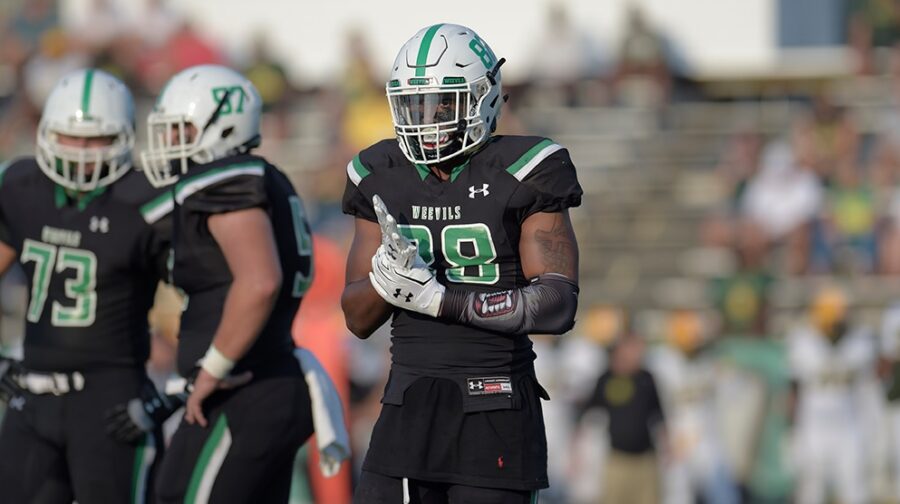
Height: 6’2”. Weight: 247 lbs.
Pros: Though a longshot to be drafted, it would not be a surprise to see Washington hang onto a roster spot were he to get an opportunity in a training camp. He features a powerful, toned frame with physicality and toughness that can hold up in the NFL. There is the potential to provide a versatile depth role at the back end of a roster. Contributing on most or all special teams units would be a likely path. He also can provide on offense as a full back and H-back with translatable receiving ability.
Washington led Arkansas-Monticello in receiving yardage in his final season, despite his varied role. He saw significant time out wide, in addition to the slot, inline and in the backfield. The Boll Weevils standout totalled 36 receptions for 625 yards (17.36 per catch) and 7 touchdowns in only 9 games in 2019. He uses his strong frame both as a blocker and as he fights for position as a route runner.
Though relatively short as a tight end, he is well built for a full back role. His 32” arms and 77” wingspan offers solid length. Washington shows strong hands at the catch point and uses his body advantageously under tight coverage. Off the line, he is tough to disrupt off his route path.
Cons: Washington is a solid athlete with enough straight-line speed. However, his film suggests he may not be overly explosive and dynamic in shorter areas. Getting plenty of wins by outmuscling overmatched Division 2 competition, he won’t dominate matchups to the same extent in the pros. Though Washington could provide depth, his ceiling could be limited to a backup or rotational role.
Wrapping Up: A standout at the Gridiron Small School Showcase, Washington took advantage of an opportunity to impress scouts. There are some limitations to his skill set and tools but maximizes his best traits. He uses his frame and strength well and rarely drops a catchable pass. Most likely, the Arkansas-Monticello tight end goes undrafted. That said, with the right team fit, there’s potential to earn a special teams and H-back role. A practice squad spot could also be an option.
39. TJ Roberts, RB, Central Oklahoma. Grade: UDFA
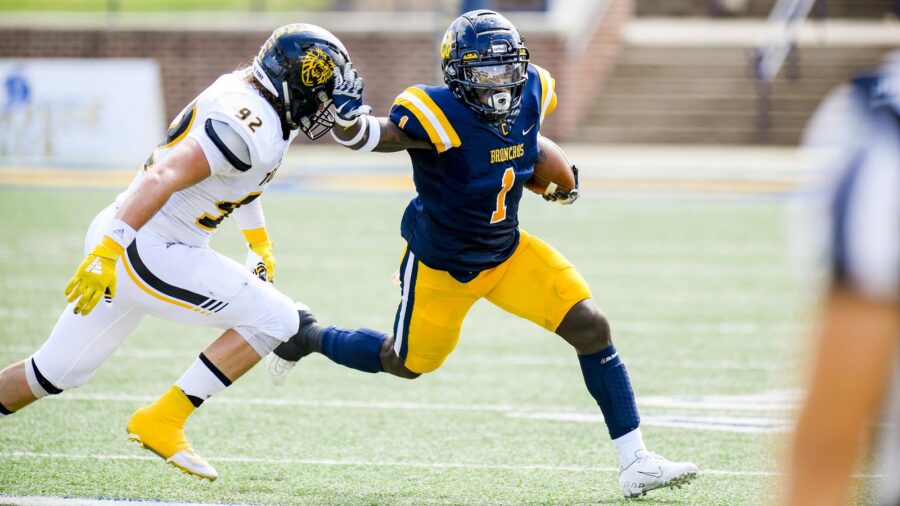
Height: 5’9”. Weight: 200 lbs.
Pros: After two seasons at the JUCO level with Mesa College, Arizona, Roberts landed at UCO for his 2019 junior season. His workload wasn’t heavy, yet he maximized his touches to lead the team in rushing. On 127 attempts, Roberts put up 668 yards at a 5.3 yards per carry average and 10 touchdowns. He added 13 receptions for a further 97 yards.
Roberts is of slightly leaner build but is certainly not skinny or undersized. He has a toned build that suits his shifty and effective running style. The effort in pass pro is always present. There are good flashes of agility, lateral cuts and overall short-area quickness on film. What commonly stands out is patience setting up his blocks, picking his spots with good timing to the hole. He is better than expected between the tackles, with nice shifts through congestion, able to get skinny and slippery to find a path to the second level.
The Bronchos back is generally a consistent and reliable decision maker with good vision. He is not prone to much hesitation or dancing in the backfield. It felt as though his ability to make positive runs was limited at times by the execution of his O-line in front. Roberts makes plays in a variety of areas, both inside and outside as a runner and as a receiver. He works well laterally and can win angles to the edge at the lower levels. In the pass game, he shows good burst out of his breaks as a route runner. Adjusting well to the football, he displays good body control and hands.
Cons: There are no obvious flaws or gaps in Roberts’ game, doing most things competently. That said, there may also be no standout traits to separate himself from the pack of late round to free agent running back prospects. He is evasive in space and tricky between the tackles at the D2 level but might be less effective in those areas against NFL defensive talent. He is capable but doesn’t appear to consistently break tackles once defenders get hands on him. The UCO runner absolutely finishes each run though, often driving forward for extra yardage.
Wrapping Up: There are two small school running backs receiving plenty draft buzz this cycle. Tiffin’s JaQuan Hardy and Saginaw Valley State’s Nate McCrary have a chance to be drafted on Day 3. Roberts probably is a free agent prospect and grades below that pair. Even so, Roberts feels under-discussed at this point. With the right opportunity, he could be a rotational back utilized in space and on short passing targets. Hopefully he gets an opportunity in training camp.
40. Ameer Hollowell, IOL, Wisconsin-Oshkosh. Grade: UDFA
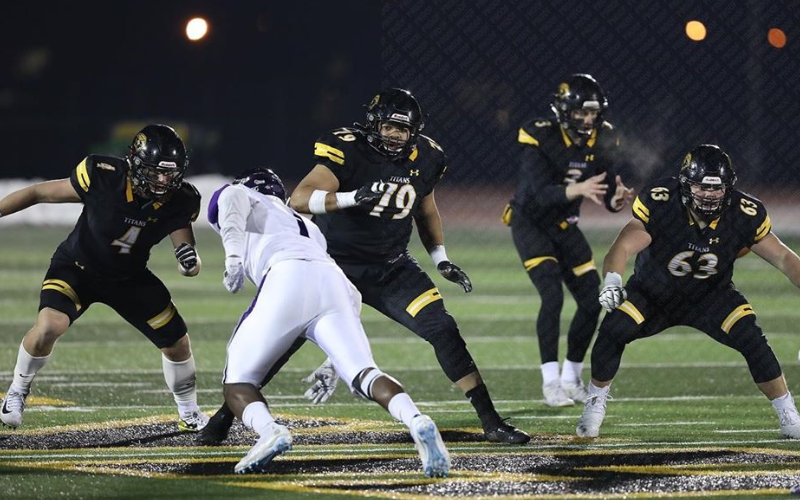
Height: 6’3”. Weight: 333 lbs.
Pros: The determination to succeed and achieve goals will not be questioned regarding Hollowell. He also had the potential to play at a higher level out of high school. Hollowell had a recruitment offer from Vanderbilt in the SEC dependent on academics but was unable to achieve the requirements. He bounced around different schools and enrolled at a local community college to assist his grandmother to care for his grandfather with dementia. He worked to earn the opportunity with Division 3 school Wisconsin-Oshkosh in 2019.
Hollowell played right tackle for the Titans but projects better inside. His stocky wide build is ideal for the interior. He has the strength and frame to hold up at the point of attack and handle bull rushes when he is set with good form. The O-line prospect seems to enjoy and thrive in the physical nature of playing in the trenches. He runs his feet through contact, generating backward movement. There are impressive flashes in the run game to control the opposition, blow open holes, dominate and knock down defenders.
Cons: Hollowell has the bulk and power to hold his ground and absorb power rushes. However, he currently plays with generally poor form, coordination and footwork. There are times his anchor can be raised and knocked off balance due to the footwork, leverage and control. Perhaps a factor of his difficult path through college, but Hollowell appears a little raw at this stage.
There is some wasted motion in his lower body as he executes his pass pro sets. When changing directions, he can be inefficient in resetting his feet as he redirects. In his upper body technique, the hand placement is inconsistent, frequently connecting too far outside his intended mark. In turn, he can give up his chest to the opponent on occasion.
Wrapping Up: There are many in the latter half of this draft board who could prove far too lowly ranked in hindsight. Ameer Hollowell could end up in that category. He requires significant technical improvements, but all indications suggest he has the commitment to take well to that coaching. The work ethic and determination are clear both on and off the field. At 6’2 and a half with 32” arms, Hollowell projects to move from right tackle inside to guard.
Feature Image Credit: Stony Brook Athletics

rebecca rennie
CFB/NFL DRAFT analyst
Rebecca is an NFL Draft analyst focusing primarily on the FCS and Group of Five conferences, and a fan of both the Tampa Bay Buccaneers and Stanford Cardinal. You can find her other articles here and follow on Twitter @bex_r86.
